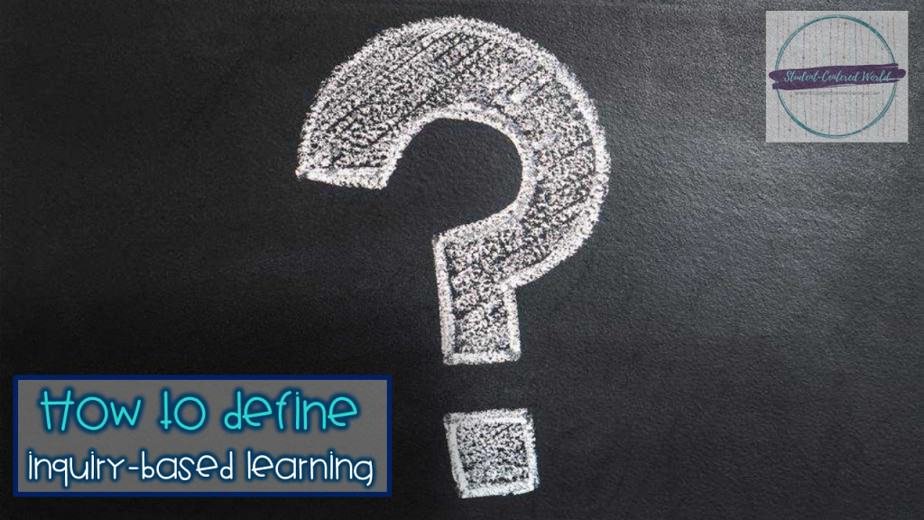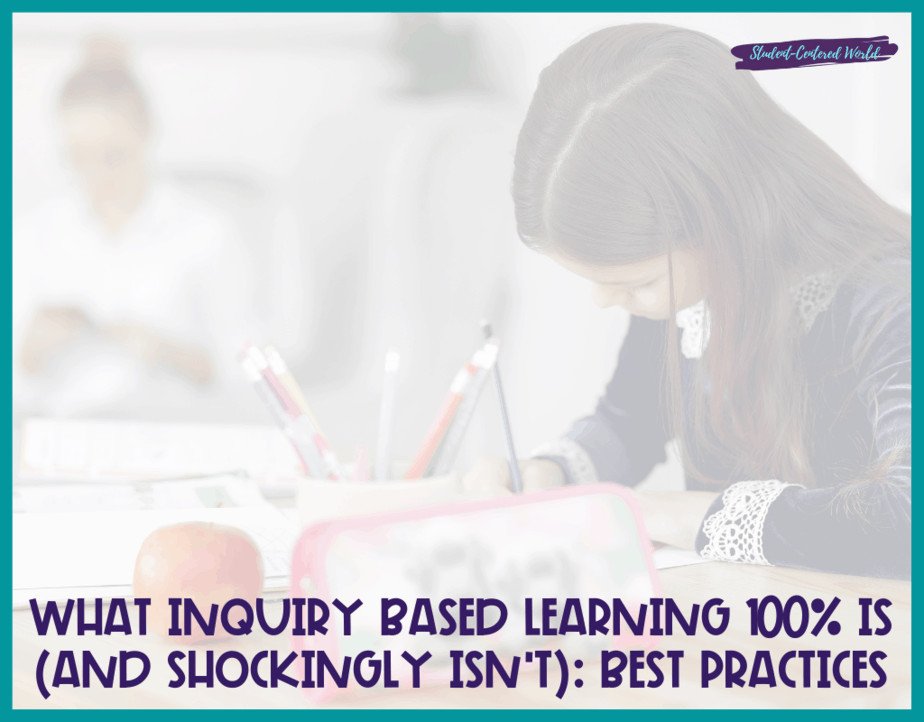Inquiry-Based Learning: What it is and its Benefits
Many people ask me to explain inquiry-based learning in simple terms. With so much educational jargon floating around, it’s no surprise that teachers can get confused about what different terms mean for them and their students.
Defining Inquiry-Based Learning
So, how do we define inquiry-based learning, integrate it into the learning process, and determine if this instructional model is best for your classroom?
Inquiry-based learning (IBL) is a teaching method where students explore topics of personal interest by posing their own questions and designing investigations. This type of learning encourages them to make connections between ideas, things, and processes in different ways.
Also known as problem-based learning or project-based learning, IBL is described as ‘educating the heart, mind, and hands’ and fosters critical thinking.
The Inquiry Process
In an inquiry-based approach, students ask questions about topics they are interested in. Recording and responding to these questions leads to significant learning driven by the student’s intrinsic motivations. Inquiry-based teaching helps students make sense of their world by posing their own research questions, collecting the necessary data, and interpreting their findings.
This method enhances critical thinking and problem-solving skills, fosters deeper understanding and retention of knowledge, and promotes active engagement and ownership of learning.
According to Heather Wolpert-Gawron’s post on Edutopia, “Inquiry-based learning is more than asking a student what he or she wants to know. It’s about triggering curiosity. And activating a student’s curiosity is, I would argue, a far more important and complex goal than the objective of mere information delivery.
Nevertheless, despite its complexity, inquiry-based learning can be somehow easier on teachers, too. True, it’s seemingly easier because it transfers some responsibilities from teachers to students, but it’s really easier because releasing authority engages students.”
Additionally, it develops transferable skills such as evidence-based reasoning, communication, and collaboration, making students better prepared for real-world challenges and lifelong learning. By addressing individual needs and accommodating different learning styles, inquiry-based learning also supports diverse learners, including younger children and advanced students.

(This post may contain affiliate links that won’t change your price but will share some commission. As an Amazon Associate, I earn from qualifying purchases. Please read our disclosure policy for more information.)
Teacher’s Role in Inquiry-Based Learning
Teachers must temporarily set aside their role as “the expert”. Instead of supplying all the answers, they guide students in forming their own questions and designing investigations to answer them. This approach encourages active engagement, ownership of learning, and a deeper understanding of content, accommodating different learning styles. By interacting more closely with students during this process, teachers can build stronger relationships and provide more personalized support.
This increased interaction allows teachers to better understand each student’s unique learning process, strengths, and areas needing improvement. As a result, teachers can more effectively gauge student progress and tailor their guidance to meet individual needs, ensuring that each student is fully engaged and making meaningful connections with the material.
This dynamic creates a supportive and responsive learning environment where students feel valued and motivated to explore their interests deeply.
Implementation Across Subjects and Grades
Inquiry-based learning can be implemented in any subject area and at any grade level, including secondary schools and high school students. It’s versatile and can be used to teach everything from historical events in social studies classrooms, where students might investigate the causes and effects of major events, to scientific methods in inquiry-based science lessons, where they design and conduct experiments to test hypotheses.
In math classrooms, for instance, students can explore real-world applications of mathematical concepts, such as investigating the principles behind quadratic equations through hands-on projects.
This method nurtures critical-thinking skills as students analyze information and evaluate different perspectives. It enhances problem-solving skills by challenging students to find solutions to complex problems through evidence-based reasoning.
Additionally, it fosters communication skills through collaborative activities, such as small-group discussions, where students share their findings and debate ideas. Inquiry-based learning also encourages students to develop their own questions and follow through with the research process, promoting self-directed learning and a deeper understanding of the subject matter.
This approach is particularly effective in middle school classrooms, where it helps bridge the gap between concrete and abstract thinking, and in elementary settings, where it taps into children’s natural curiosity and enthusiasm for discovery.
The Inquiry-Based Learning Process
At its core, inquiry-based learning involves student teams learning about topics of interest by posing their own research questions, gathering information from various sources, forming ideas based on this information, and testing these ideas through projects and reports. Students begin by identifying a particular problem or area of interest and then brainstorm good questions to guide their research.
They gather data from a variety of sources, including books, academic journals, online databases, and expert interviews. This information is then analyzed and synthesized to form hypotheses or new ideas.

Students then design experiments or projects to test these hypotheses, applying methods such as the scientific method or case study analysis. For example, in a science class, students might conduct lab experiments to observe chemical reactions, while in a social studies class, they might analyze primary source documents to understand historical events. Throughout this process, students are actively engaged in hands-on activities, enhancing their cognitive skills and making learning tangible.
This experiential learning approach not only helps students develop new understandings but also equips them with transferable skills applicable to real-world problems. They learn to work collaboratively in teams, communicate their findings effectively through presentations and reports, and apply critical thinking to solve complex issues. These skills are invaluable for their future academic and professional careers, making inquiry-based learning a powerful tool for fostering lifelong learning and adaptability.
The Benefits of Inquiry-Based Learning
The benefits of inquiry-based learning include fostering critical thinking, enhancing problem-solving skills, and promoting lifelong learning. This approach supports student success by encouraging students to engage deeply with the material, ask thought-provoking questions, and share ideas through small-group discussions and other collaborative activities. By promoting a hands-on and minds-on approach, students are more likely to retain information and understand concepts at a deeper level.
Inquiry-based learning cultivates critical thinking by requiring students to analyze information, evaluate evidence, and consider multiple perspectives before drawing conclusions. This method also enhances problem-solving skills, as students must navigate the research process, overcome obstacles, and devise creative solutions to the questions they explore. As they investigate and experiment, they learn to apply evidence-based reasoning to real-world problems, making their learning experience relevant and practical.
Moreover, inquiry-based learning promotes lifelong learning by instilling a sense of curiosity and a love for discovery. Students become self-motivated learners, eager to explore new topics and challenges beyond the classroom. This intrinsic motivation is crucial for continuous growth and adaptation in an ever-changing world.
This approach also helps meet the individual needs of students, making it suitable for younger children and advanced students alike. Younger children benefit from the exploratory nature of inquiry-based learning, which aligns with their natural curiosity and enthusiasm for learning. They develop foundational inquiry skills, such as asking questions and seeking answers, which are critical for their cognitive development.
For advanced students, inquiry-based learning provides opportunities to delve deeper into complex subjects and pursue independent research projects. This level of autonomy and intellectual challenge helps them develop advanced understanding and high-level cognitive skills. The flexibility of this teaching method allows educators to tailor lessons to the diverse interests and abilities of their students, creating an inclusive learning environment that supports all learners.
Types of Inquiry-Based Learning
There are different models and types of inquiry-based learning, including open inquiry and guided inquiry approaches, each offering distinct levels of autonomy and support for students.
Open Inquiry
Open inquiry allows students to pose their own questions and design their investigations entirely from scratch. This model provides the highest level of independence, encouraging students to take full ownership of their learning process. They formulate research questions, decide on methodologies, gather data, and draw conclusions with minimal guidance from the teacher.
Open inquiry is particularly effective for developing advanced inquiry skills, such as critical thinking, problem-solving, and evidence-based reasoning. It fosters a deep sense of curiosity and intrinsic motivation, as students explore topics that genuinely interest them. This approach is ideal for advanced students or those ready for more significant challenges, as it demands a high level of self-direction and cognitive skills.
Guided Inquiry
In contrast, guided inquiry provides more structure and support from the teacher, making it suitable for students who may need additional direction. In this model, the teacher plays a more active role in shaping the investigation process. They might provide the research question or a framework for the inquiry, while students focus on exploring and finding answers within those parameters.
The teacher offers guidance, resources, and scaffolding to help students navigate the research process.

Guided inquiry is beneficial for building foundational inquiry skills, especially for younger children or students new to this method of learning. It ensures that all students can engage with inquiry-based learning at their own pace, gradually building their confidence and capabilities.
Combined Approaches
Teachers can also employ a combination of open and guided inquiry, adjusting the level of support based on students’ needs and the complexity of the topic. For example, a unit might begin with guided inquiry to introduce essential concepts and gradually transition to open inquiry as students become more comfortable and skilled.
Benefits of Both Models
Both open and guided inquiry approaches help develop important skills such as evidence-based reasoning and cognitive skills. By engaging in the process of inquiry, students learn to ask meaningful questions, conduct thorough research, analyze information critically, and communicate their findings effectively. These skills are crucial for academic success and valuable in real-world contexts, fostering lifelong learning and adaptability.
Starting with Inquiry-Based Learning
To begin implementing inquiry-based learning, gather the necessary equipment and supplies for your learning experience. Plan and prepare each step of the investigation process, ensuring ample time for students to conduct their experiments, record and evaluate results, and ask deeper questions about what they learned. Utilize resources such as lesson plans, helpful rubrics, and professional development opportunities to support your teaching approach.
In practice, implementing these models in the classroom involves careful planning and flexibility. Teachers need to create a supportive environment where students feel safe to take risks and make mistakes. This might include providing a variety of resources, setting clear expectations, and offering continuous feedback. Collaborative activities, such as small-group discussions and peer reviews, can further enhance the inquiry process by allowing students to share ideas, debate different perspectives, and learn from one another.
Practical Applications
- Real-World Problems: Inquiry-based learning helps students tackle real-world problems and engage in civic life.
- Field Trips: Use field trips to spark students’ curiosity and provide context for their inquiries.
- Case Studies: Implement case studies to deepen understanding of complex issues.
- Small Groups: Encourage small-group discussions to facilitate collaborative learning.
- Social Studies Curricula: Incorporate inquiry-based lessons into social studies to explore historical events and civic issues.
- Science and Math: Apply the scientific method and problem-solving skills in science and math classrooms.
- International Journals: Have students reference international journals to gather diverse perspectives.
- Common Core Alignment: Ensure that inquiry-based activities align with Common Core standards.
Conclusion
Inquiry-based learning is a powerful teaching method that shifts the focus from teacher-centered instruction to student-centered learning. By encouraging students to explore topics of interest, pose their own questions, and conduct investigations, teachers can create an environment of active engagement and deeper understanding. This approach not only enhances student performance but also fosters a lifelong love of learning.
Inquiry-based instruction effectively boosts student engagement by making learning relevant and interesting. By focusing on students’ interests and encouraging them to ask meaningful questions, teachers can promote a deeper understanding of the material. This teaching method not only prepares students for academic success but also equips them with essential skills for lifelong learning and civic engagement.
Stop Driving the Teacher Struggle Bus
Are you struggling with student engagement, apathy, or keeping your class on track?
💫💫 There’s hope! 💫💫
If you’re ready to take the first step towards reviving student engagement and transforming your classroom, I invite you to join me for my free workshop “Reversing Student Apathy” designed to equip educators with innovative strategies that work.
This free teacher workshop offers educators a valuable opportunity to explore and address student apathy. By examining its causes and discussing strategies, participants will learn how to make meaningful changes in their teaching methods that are actually working. The sessions are engaging and collaborative, allowing educators to share experiences and develop a collective approach to improving student engagement.
Highlights include:
- Understanding the roots of student apathy and its impact.
- Strategies for enhancing classroom dynamics.
- The importance of educator-student relationships.
- Innovative teaching approaches for today’s students.
By the end of the workshop, you will not only understand what you need to accomplish to stabilize the 4 pillars of your classroom, but you will also walk away with 5 tangible ideas to try in the classroom the very next day.
Join today to be part of the solution to reigniting student enthusiasm and engagement.
This article was originally published on May 12, 2018






